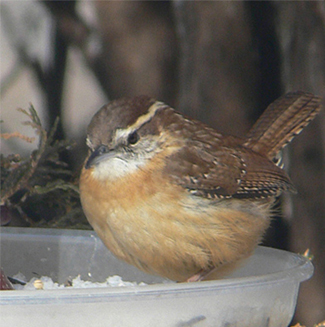
This month I would like to start with a bit of scientific sleuthing. As a refresher (for me at least), a “type specimen” (at the species level and in scientific terms) is usually a physical specimen of a species that is kept in a museum or herbarium research collection, but, failing that, at least an image (including drawings) of an individual of that species. Under the formal rules for naming species, each species must have a type specimen; accompanying the type specimen is the “type description” that describes the type specimen and the similarities to, and differences from, closely related species. The “type location” is where that type specimen was collected/found.
The Carolina Wren (Thryothorus ludovicianus), I suspected, would be interesting to research from this perspective. Having grown up in North Carolina I was curious to know if the type specimen was from North or South Carolina (one of which I fully expected it to be) and, if so, near what town the type specimen was found. Well, the search bloomed into a much broader story than I had expected, and a more interesting one. I found much of the information I was seeking in Dictionary of Birds of the United States, by J. E. Holloway (2003), and use it liberally here, as well as some information from websites on the subject. The species part of the name, ludovicianus, means of the Louisiana Territory (exactly how you get the Latin ludovicianus from Louisiana I don’t know, but let’s move on anyway). The collector of the type specimen for Carolina Wren was John Latham, an English naturalist and physician, the year collected 1790, and the type location was almost certainly in or near New Orleans, although Louisiana Territory covered a huge area at the time, including all of what is now Oklahoma.
As something of an afterthought the common name Carolina Wren, was applied much later merely to indicate that the bird was found in the southeastern U.S. in general. So my original assumption about the type location being in one of the Carolinas was quite wrong. But then, who would have guessed “Louisiana Territory” from “Carolina Wren.”
The Carolina Wren is a permanent resident of most of Oklahoma—they get scarce to non-existent as you go west in the Oklahoma Panhandle. They sing all year long, a semblance of their song being “teakettle-teakettle-teakettle.” They build somewhat bulky nests that are entered from the side, and normally lay 4-6 eggs, but most often 5. They use a wide variety of places to nest, often around human habitations, places such as tin cans, pockets of old clothing hanging in sheds, mail boxes and bird boxes; one report was of a nest in a tractor that was frequently used on a farm—this nest successfully fledged young (Bent, A. C., Life histories of North American Nuthatches, Wrens, Thrashers and their allies, 1964).
At our house we have had a pair of these wrens nest for several years in a hanging plant on our porch, under an overhanging part of the house which would keep the nest and birds dry in a rainstorm. One year the birds built their nest very quickly after we first hung the plant out long after the beginning of the nesting season. I have heard of similar hanging plant experiences from others.
The Carolina Wren has been expanding northward for many years, but they are not an exceptionally cold-hearty species. Especially toward the fringes of its range, when deep snow or heavy ice covers the landscape for an extended period of time, most Carolina Wrens do not survive. In central Oklahoma there were severe ice storms for 2 consecutive winters in the late 1970s, and it wiped out virtually all of the Carolina Wrens. It took 10 years for Carolina Wrens to once again become a common species here.
